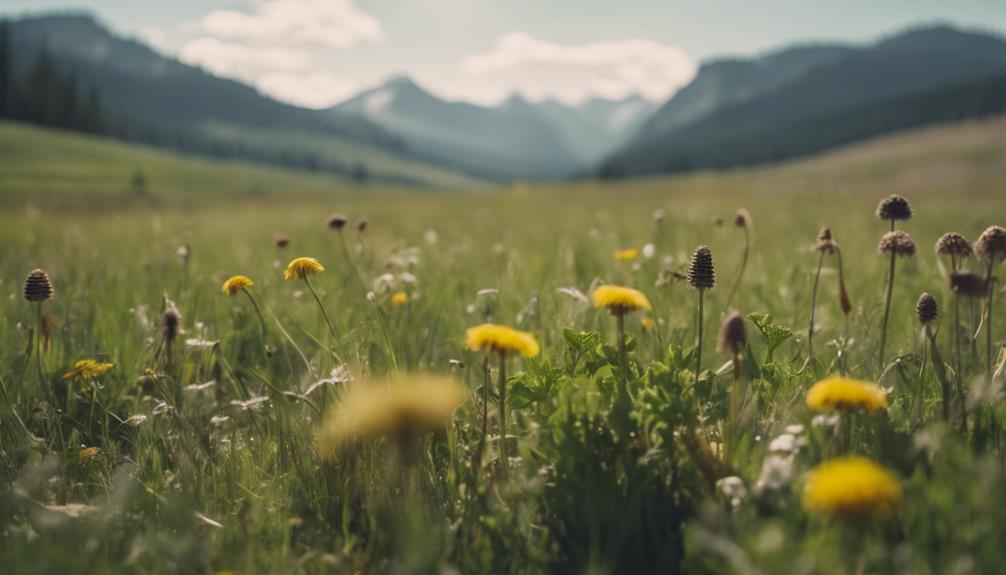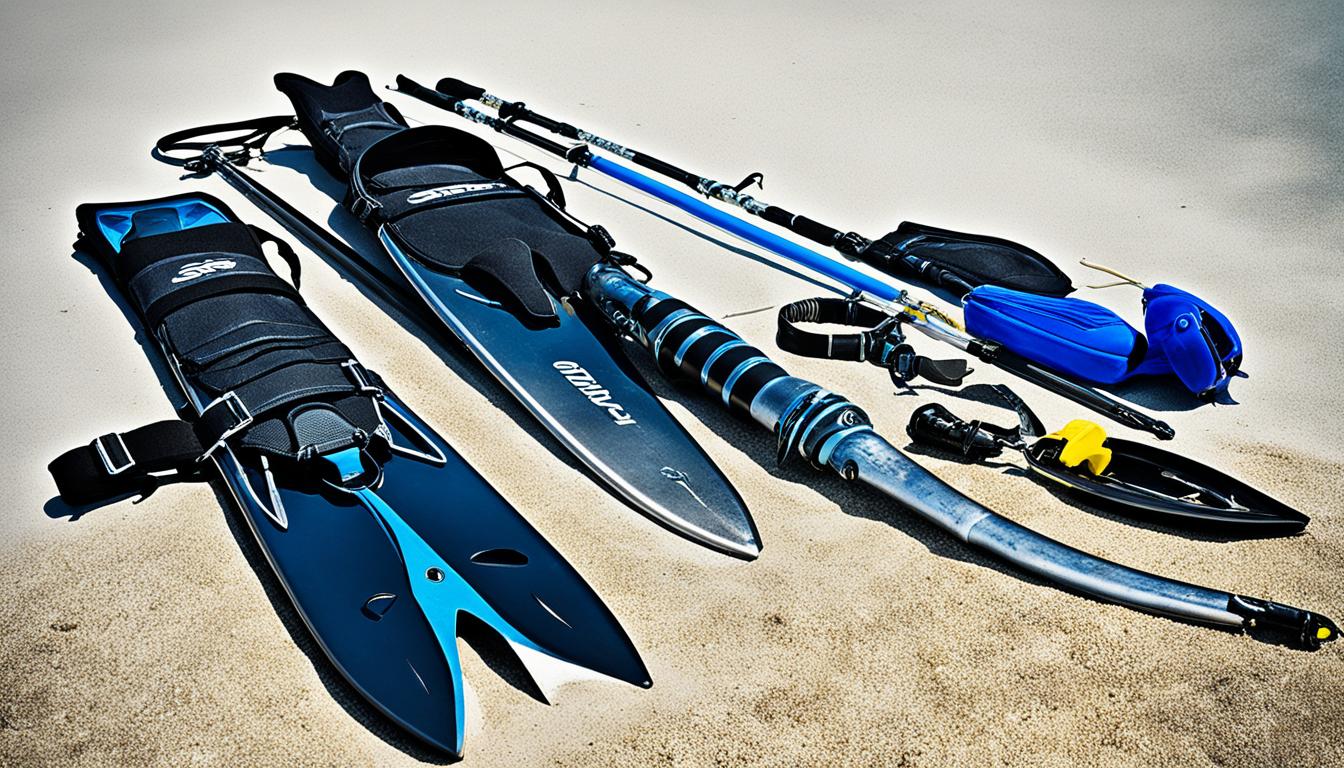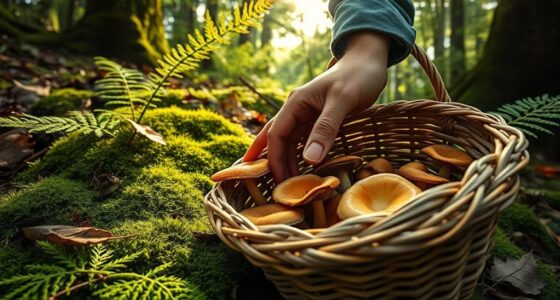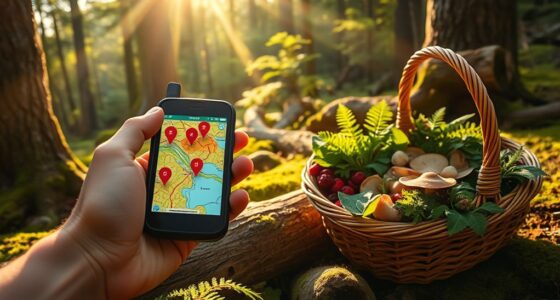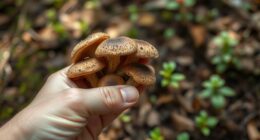As you explore Montana's wilderness, you'll uncover a world of edible wild plants waiting to be discovered. From bitterroot to king boletes, these native plants offer medicinal benefits, culinary delights, and a connection to the state's cultural heritage. To forage responsibly, master identification skills, respect land regulations, and adopt sustainable practices to preserve ecosystems. With the right techniques, you can harvest wild berries, mushrooms, and herbs while maintaining ecological balance. As you venture into Montana's wild harvest, you'll uncover a treasure trove of flavors, nutrients, and natural remedies – and discover the secrets to responsible foraging and cultural appreciation. Likewise, foraging in Tennessee offers its own unique bounty, from wild persimmons to ramps, each providing valuable nutrients and traditional uses. By applying the same principles of sustainable foraging, you can ensure that both Montana’s and Tennessee’s ecosystems continue to thrive for generations to come. Remember, a key part of responsible foraging is not only about what you take, but also how you contribute to preserving the land for future explorers and local wildlife.
Key Takeaways
- Montana's native edible plants, like bitterroot and chokecherry, offer medicinal benefits and connect with the state's cultural heritage.
- Proper identification skills are crucial for safe foraging and adhering to land regulations prevents ecosystem damage.
- Sustainable foraging practices, like respectful harvesting and mindful picking, maintain ecological balance and preserve native plants.
- Wild berries, mushrooms, and herbs can be harvested mindfully, considering seasonal availability and growth cycles to ensure long-term ecosystem health.
- Embracing native plants and participating in conservation efforts is crucial for preserving Montana's wild harvest and ensuring abundant natural resources.
Montana's Native Edible Plants
As you venture into Montana's vast wilderness, you'll discover a diverse array of native edible plants, each with its unique characteristics and uses, waiting to be foraged and savored.
Montana's ecosystem is home to an array of delicious and nutritious plants, such as Bitterroot, chokecherry, morels, chanterelles, and king boletes. These plants have been traditionally used by indigenous peoples for their medicinal benefits, providing a rich source of nutrients and natural remedies.
Foraging for native edible plants isn't only a great way to connect with Montana's cultural heritage, but it also supports the state's biodiversity.
However, understanding the unique characteristics of each plant is vital to ensure safe foraging. Proper identification skills and adherence to land regulations are crucial to avoid misidentifying plants or damaging the ecosystem.
Sustainable Foraging Practices

As you venture out to forage for Montana's wild edibles, remember that sustainable practices are vital to preserving the state's natural beauty.
You'll need to respect the land, know what to pick, and leave some behind to guarantee that these wild plants continue to thrive for future generations.
Respect the Land
You'll want to adopt sustainable foraging practices to guarantee Montana's wild plants thrive for generations to come. As you venture into Montana's wilderness, remember that responsible foraging is key to maintaining ecological balance and preserving plant diversity.
Ethical foraging involves respecting land regulations, harvesting in season, and accurately identifying plants to avoid mistakenly picking endangered species. Conservation efforts focus on preserving native plants and habitats, ensuring the long-term health of Montana's ecosystems. By adopting sustainable foraging practices, you're supporting these efforts and contributing to the conservation of Montana's natural beauty.
When foraging, monitor plant populations, minimize your impact, and consider supporting restoration projects. By doing so, you'll be ensuring the availability of wild plants for future generations. Remember, sustainable foraging is a vital step in preserving Montana's natural heritage. By respecting the land and adopting responsible foraging practices, you're helping to maintain the delicate balance of Montana's ecosystems.
Know What to Pick
When foraging in Montana's wilderness, identify the right plants to pick by understanding seasonal availability and plant growth cycles to guarantee sustainable harvesting. This guarantees that you're not over-harvesting and allowing the native plants to thrive. As a responsible forager, it is crucial to adopt sustainable foraging practices that prioritize conserving native plants and habitats.
| Plant | Seasonal Availability | Harvesting Techniques |
|---|---|---|
| Wild berries | Summer-fall | Mindful gathering, avoid over-picking |
| Wild mushrooms | Spring-fall | Cut at base, avoid damaging mycelium |
| Dandelion greens | Spring | Harvest before flowering, avoid roots |
| Wild herbs | Summer | Pinch or cut, avoid uprooting |
| Burdock root | Fall | Dig carefully, avoid damaging roots |
Leave Some Behind
To forage responsibly in Montana's wilderness, leave a significant portion of the harvested plants behind to guarantee the long-term health and sustainability of the ecosystem. This secures that plant populations remain healthy, and over-harvesting is avoided. By doing so, you're contributing to conservation efforts and supporting the biodiversity of Montana's ecosystems.
Here are some key considerations for sustainable foraging practices:
- Understand the life cycle of the plants you're harvesting to avoid disrupting their growth patterns
- Be mindful of seasonal variations and ecosystem impacts
- Educate yourself on responsible foraging techniques to maintain wildlife habitats and preserve natural landscapes
- Respect plant populations and avoid over-harvesting to secure their long-term survival
Edible Wildflowers and Herbs

As you venture into Montana's wilderness, the vibrant colors of edible wildflowers and herbs like Bitterroot, wild mint, and Camas catch your eye, enticing you to discover their culinary and medicinal secrets.
These plants have been utilized for centuries by indigenous peoples for both culinary and medicinal purposes. Bitterroot, known for its pink flowers, is a symbol of Montana and has a sweet, edible root. Wild mint adds an invigorating flavor to dishes and teas, while Camas bulbs are nutritious and starchy.
Understanding the characteristics and uses of these wildflowers and herbs is essential for safe foraging in Montana. When foraging for edible wildflowers and herbs, it's important to identify them correctly to avoid mistaken identity. Take your time to learn about the different species, their habitats, and growth patterns.
This knowledge will allow you to harvest these wild treasures responsibly and enjoy their unique flavors and benefits. By doing so, you'll not only savor the flavors of Montana's wild harvest but also appreciate the rich cultural heritage of indigenous peoples.
Nutritional and Medicinal Value

As you explore Montana's wild harvest, you'll discover a treasure trove of nutrient-dense greens and medicinal compounds. Rich in minerals and antioxidants, wild plants like camas and chokecherries can elevate your health and wellness.
Now, let's examine the specific benefits of mineral-rich wild greens and medicinal plant compounds, and how they can enhance your diet and daily life.
Mineral-Rich Wild Greens
You can tap into the nutritional powerhouse of wild greens, which boast an impressive array of minerals like calcium, magnesium, and iron, all essential for maintaining overall health and wellbeing. These wild plants are packed with vitamins A, C, and K, offering immune-boosting and antioxidant properties. By incorporating wild greens into your diet, you can enhance your nutrient intake and add unique flavors to your meals.
Here are some benefits of consuming mineral-rich wild greens:
- Supports bone health, digestion, and detoxification processes in the body
- Provides vitamins A, C, and K, which offer immune-boosting and antioxidant properties
- Has been used in traditional medicine for its healing and anti-inflammatory benefits
- Adds unique flavors to your meals, enhancing your culinary experience
Incorporating wild greens like lamb's quarters, dandelion greens, stinging nettle, and chickweed into your diet can have a significant impact on your overall health. By foraging for these wild plants, you can reap the benefits of their mineral-rich properties and experience the unique flavors they've to offer.
Medicinal Plant Compounds
Beyond the impressive mineral profile of wild greens, Montana's wild edible plants are also rich in medicinal compounds that offer a wealth of nutritional and healing benefits.
As you forage for wild plants, you'll discover a treasure trove of medicinal herbs that serve as a valuable source of vitamins and minerals. These compounds contribute to overall health by boosting immunity, improving digestion, and reducing inflammation.
Many traditional Native American remedies have utilized these plant compounds for their medicinal uses, and understanding their nutritional and medicinal value can enhance your well-being and promote natural healing.
Wild plants are a rich source of food and medicine, providing a lot of health benefits when consumed as part of a balanced diet. By incorporating these medicinal plants into your diet, you'll not only enjoy their flavor and texture but also reap the rewards of their medicinal properties.
As a source of vitamin-rich nutrition, Montana's wild edible plants are a gift from nature, offering a unique opportunity to tap into the health benefits of wild, natural food.
Culinary Uses of Wild Plants

What culinary secrets can wild plants like cattails, dandelions, and berries reveal in your kitchen? As you forage for these nutritious wild plants, you'll discover a world of flavors and textures to elevate your cooking.
Here are some culinary uses of wild plants to get you started:
- Cattails provide a gelatinous starch perfect for thickening soups, while their shoots and roots are edible and nutritious.
- Dandelions are rich in vitamins A, C, and K, with edible flowers, leaves, and roots that can be used in various dishes.
- Wild berries are high in vitamin C and perfect for snacking, desserts, or making jams.
Understanding the nutritional content and harvesting techniques of wild plants enhances their culinary appeal and health benefits.
Preserving Montana's Wild Harvest

As you venture into the world of wild plants, it's important to acknowledge the significance of preserving Montana's wild harvest, guaranteeing that these natural resources remain abundant for generations to come.
You can play a crucial role in maintaining the ecosystem's balance by adopting sustainable foraging practices. This not only secures the long-term survival of native edible plants but also promotes biodiversity.
Conservation efforts are essential to protect Montana's diverse habitats and the native plants that thrive within them. Invasive species management is critical to prevent the spread of non-native species that can outcompete native plants for resources. By embracing native plants, you're supporting a healthier ecosystem and reducing the need for external inputs.
Community involvement is key to preserving Montana's wild harvest. You can get involved by participating in research, education, and conservation initiatives. By working together, we can ensure that these natural resources remain abundant for future generations.
Frequently Asked Questions
How Do You Forage Wild Edible Plants?
You identify edible plants, avoiding toxic look-alikes, and harvest sustainably to preserve ecosystems. You learn about nutritional benefits, culinary uses, and conservation efforts, then adapt harvesting techniques for roots, leaves, flowers, and fruits.
How Do You Know if a Wild Plant Is Edible?
You navigate the wild like a detective solving a mystery, searching for clues to determine if a plant is edible. You scrutinize its leaf shape, stem structure, and flower color, cross-checking with reliable field guides to confirm its edibility.
Where Is the Best Place to Forage Plants?
You'll find the best foraging spots in diverse ecosystems like prairies, forests, and mountains, where you can discover a wide variety of edible plants, especially in areas like the Great Plains and Rocky Mountains.
Which of the Following Herbs May Be Harvested From the Wild?
"A million possibilities await you in the wild! When it comes to foraging, you'll find that wild mint, white wild onion, and yucca are just a few of the herbs you can harvest from the wild, adding a touch of nature to your dishes."
Conclusion
As you venture into Montana's wilderness, remember that foraging for wild plants isn't only a fun adventure, but also a way to connect with nature and nourish your body.
Take the example of Ellen, a Bozeman resident who forages for wild chamomile to make a soothing tea that helps her sleep better.
By embracing sustainable foraging practices and respecting the land, you can harness the full potential of Montana's wild harvest and reap its delicious and nutritious rewards.

